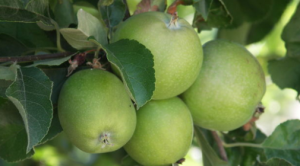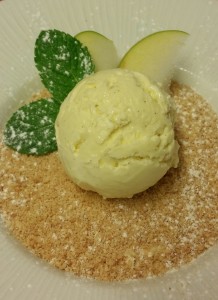As we are in the middle of Bramley Apple Week, you knew that didn’t you, I wanted to give you a failsafe recipe for that most English of desserts the apple crumble, and you cannot make an apple crumble without a Bramley apple. In 1809 a Southwell* resident, Mary Ann Brailsford planted some apple pips one of which still bears fruit to this day. In 1846 her cottage and garden were sold to one Matthew Bramley and apart from shelling out the cash that is his total contribution. A local nurseryman admired the quality of the apples and asked to be allowed to take some grafts to develop more trees capable of producing the fruit. Matthew Bramley agreed to this on the condition that if the apples went on to any commercial success they would bear his name. The Bramley is now famous and cooks love it for its flavour and excellent cooking qualities. It remains one of the most widely grown British culinary apples.
 The crumble is a quick and easy pudding that can be adapted to suit the seasons and the different fruits available often partnering softer fruits with apples or pears and enhancing the flavour with the use of spices. Apple crumble is the most popular version of the dish and due to the keeping quality of apples traditionally a staple throughout long winters when very few fresh fruits were available. Apples such as Bramley’s would have been stored in a loft or attic to provide a valuable source of vitamin C from November to February. Today your apples are shipped into supermarkets from around the world to overcome seasonality.
The crumble is a quick and easy pudding that can be adapted to suit the seasons and the different fruits available often partnering softer fruits with apples or pears and enhancing the flavour with the use of spices. Apple crumble is the most popular version of the dish and due to the keeping quality of apples traditionally a staple throughout long winters when very few fresh fruits were available. Apples such as Bramley’s would have been stored in a loft or attic to provide a valuable source of vitamin C from November to February. Today your apples are shipped into supermarkets from around the world to overcome seasonality.
However, if you want to go seasonal and reduce your carbon footprint here are a few ideas spring is when rhubarb comes into its own, I pre-bake mine with brown sugar, ginger orange juice, and zest to help keep the shape and prevent the crumble becoming soggy
During the summer there is an abundance of produce, tart gooseberries with plenty of sugar, cherries, or then raspberries, strawberries, and blackcurrants and that all liven up the last of the previous year’s apples when baked together. Spiced plums, pears, apples, and blackberries are the staples of autumn and on into winter.
Crumbles are best enjoyed hot, with liberal dollops of custard, clotted cream or a scoop or two of ice cream. You can change the basic recipe for the crumble topping by mixing in oats or a sprinkling of chopped nuts and adding spices such as ginger, nutmeg, and cinnamon.
* Now in passing most people will know Southwell for its pretty minster and horse racing track but now you dear reader know Southwell is the home of the English Bramley cooking apple. The town holds an annual festival each October to celebrate the Bramley.
My Perfect Apple Crumble
1kg Bramley Apples
3 tablespoons of Apple Juice or water
2 tablespoons Caster Sugar ( approximately )
Juice of half a Lemon
½ teaspoon freshly grated Nutmeg
120 gr Self Raising Flour
100 gr Caster Sugar
75 gr Butter
Optional
40 gr Rolled Oats
40 gr Demerara Sugar
Preheat your oven to 200 C / 400 F/ Gas 6. Wash the apples, peel and cut them into quarters. Remove the cores and slice each piece of apple in two. Put the apple pieces into a medium sized, heavy bottomed pan with the apple and lemon juice and cook over a low heat for about five minutes, until the apples start to soften. I like the apples to start to break up leaving some bigger pieces for texture. Taste the apples for sweetness, sprinkle with sugar as required and carefully stir in. Add the nutmeg and gently stir again. Transfer the apple mixture to a shallow ovenproof dish.
In a bowl blend the flour and butter together by rubbing with the tips of your fingers until the mixture looks like fine breadcrumbs, alternatively you can pulse together in a food processor for a few seconds. Blend in the caster sugar thoroughly ( at this point stir in the oats and the brown sugar if required ) and then loosely sprinkle the mix over the cooked apples in the dish. Place the crumble in the oven to bake for thirty minutes or until crunchy and golden-brown on top.
Serve with custard, cream or ice cream.

